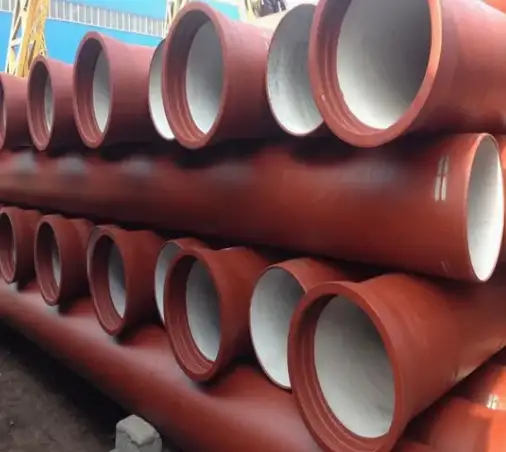Ductile iron pipes are essential components in modern infrastructure, particularly in water and wastewater systems. Understanding the cost of these pipes is crucial for engineers, contractors, and project planners to ensure budget adherence and cost-effective decision-making. This comprehensive guide delves into the factors influencing the cost of 8-inch ductile iron pipes, providing detailed insights into pricing, specifications, and considerations for procurement and installation.

1. Factors Influencing the Cost of 8-Inch Ductile Iron Pipes
1.1 Material Specifications
The cost of ductile iron pipes is significantly influenced by their material specifications, including:
-
Class Rating: Ductile iron pipes are classified based on their pressure-bearing capacity. Class 50 pipes are designed for lower pressure applications, while Class 52 and Class 53 pipes are suitable for higher pressure systems. Higher-class pipes generally cost more due to increased material strength and thickness.
-
Coatings and Linings: Pipes are often coated and lined to prevent corrosion and enhance durability. Common coatings include cement mortar and epoxy, which can add to the overall cost.
1.2 Joint Type
The type of joint used in ductile iron pipes affects both installation ease and cost:
-
Push-On Joints: These joints are cost-effective and commonly used in standard installations.
-
Mechanical Joints: Provide flexibility and are suitable for areas requiring frequent disassembly.
-
Restrained Joints: Necessary for high-pressure systems or areas with unstable soil conditions, these joints are more expensive due to additional materials and labor.
1.3 Pipe Length
Standard ductile iron pipes are typically available in 18-foot lengths. Longer lengths can reduce the number of joints required, potentially lowering installation costs. However, longer pipes may incur higher transportation fees due to increased weight and size.
1.4 Regional Variations
The cost of ductile iron pipes can vary based on geographic location due to factors such as:
-
Transportation Costs: Distance from manufacturing facilities to the project site can influence shipping expenses.
-
Local Regulations: Some regions may have specific standards or requirements that affect material costs.
-
Market Demand: High demand in certain areas can drive up prices.
2. Price Comparison Table
| Supplier | Product Description | Price (USD) per Foot | Additional Notes |
|---|---|---|---|
| U.S. Pipe | 8″ CL52 Ductile Iron Pipe with Cathodic Protection | $29.25 | Standard length, protective coating |
| A. Louis Supply | 8″ x 20′ CL52 Tyton Joint Ductile Iron Pipe | $57.50 | 20-foot length, Tyton joint |
| Louisville Water Company | 8″ Ductile Iron Pipe | $36.20 | Bid price, large quantity purchase |
| Healdsburg, CA | 8″ Ductile Iron Pipe, Class 52, Zinc | $24.44 | Municipal project pricing |
| HQ Metal (China) | 8″ Ductile Iron Pipe | $500.00 – $580.00 | Price per ton, bulk purchase |
Note: Prices are approximate and may vary based on factors such as quantity, location, and specific requirements.
3. Cost Estimation for Installation
The total cost of installing 8-inch ductile iron pipes includes both material and labor expenses:
-
Material Costs: Based on the prices provided above.
-
Labor Costs: Installation labor can range from $10 to $25 per foot, depending on the complexity of the installation and local labor rates.
-
Additional Costs: Consideration for equipment rental, trenching, backfilling, and testing.
For a 1,000-foot installation, the estimated total cost could range from $50,000 to $80,000, depending on the factors mentioned above.
4. Frequently Asked Questions (FAQs)
4.1 What is the standard length of an 8-inch ductile iron pipe?
Standard lengths for ductile iron pipes are typically 18 feet. However, some suppliers offer 20-foot lengths, which can reduce the number of joints required and potentially lower installation costs.
4.2 How does the joint type affect the cost of ductile iron pipes?
Different joint types have varying costs:
-
Push-On Joints: Generally the most cost-effective option.
-
Mechanical Joints: Offer flexibility and are suitable for areas requiring frequent disassembly, but are more expensive.
-
Restrained Joints: Necessary for high-pressure systems or areas with unstable soil conditions, these joints are the most expensive due to additional materials and labor.
4.3 Are there any cost differences between domestic and imported ductile iron pipes?
Yes, there can be significant cost differences:
-
Domestic Pipes: Manufactured within the country, these pipes may have higher labor and production costs but can offer advantages in terms of quality control and support.
-
Imported Pipes: Often less expensive due to lower manufacturing costs abroad, but may involve higher shipping fees and potential challenges with quality assurance.
4.4 How can I calculate the total cost for my project?
To estimate the total cost:
-
Determine the total footage required.
-
Select the appropriate pipe specifications (e.g., class rating, joint type).
-
Obtain pricing from suppliers.
-
Estimate labor and additional costs (e.g., equipment, permits).
-
Sum all costs to obtain the total project cost.
4.5 What are the advantages of using ductile iron pipes?
Ductile iron pipes offer several benefits:
-
Durability: Resistant to corrosion and wear.
-
Strength: Can withstand high-pressure systems.
-
Longevity: Have a long service life, reducing the need for frequent replacements.
-
Versatility: Suitable for various applications, including water and wastewater systems.
4.6 What should I consider when selecting a supplier?
When choosing a supplier:
-
Reputation: Look for established companies with positive reviews.
-
Pricing: Compare prices from multiple suppliers to ensure competitive rates.
-
Quality Assurance: Ensure the supplier adheres to industry standards and provides warranties.
-
Customer Support: Choose a supplier that offers responsive customer service and support.
5. Conclusion
Understanding the factors that influence the cost of 8-inch ductile iron pipes is essential for effective project planning and budgeting. By considering material specifications, joint types, pipe lengths, and regional variations, stakeholders can make informed decisions that align with project requirements and financial constraints. Careful selection of suppliers and consideration of installation costs further contribute to the overall success and cost-effectiveness of infrastructure projects.

